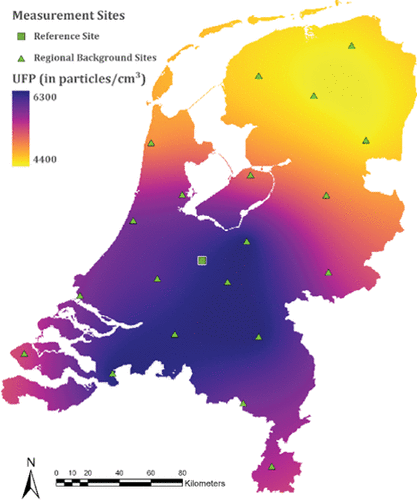当前位置:
X-MOL 学术
›
Environ. Sci. Technol.
›
论文详情
Our official English website, www.x-mol.net, welcomes your
feedback! (Note: you will need to create a separate account there.)
Spatial and Spatiotemporal Variability of Regional Background Ultrafine Particle Concentrations in the Netherlands
Environmental Science & Technology ( IF 10.8 ) Pub Date : 2020-12-30 , DOI: 10.1021/acs.est.0c06806 Esther van de Beek 1 , Jules Kerckhoffs 1 , Gerard Hoek 1 , Geert Sterk 2 , Kees Meliefste 1 , Ulrike Gehring 1 , Roel Vermeulen 1, 3
Environmental Science & Technology ( IF 10.8 ) Pub Date : 2020-12-30 , DOI: 10.1021/acs.est.0c06806 Esther van de Beek 1 , Jules Kerckhoffs 1 , Gerard Hoek 1 , Geert Sterk 2 , Kees Meliefste 1 , Ulrike Gehring 1 , Roel Vermeulen 1, 3
Affiliation

|
Studies of the health effects of ultrafine particles (UFPs) in large nationwide cohorts are currently hampered by a lack of knowledge about spatial and spatiotemporal variations in regional background UFPs. We measured the UFP (10–300 nm) at 20 regional background locations (3 × 2 weeks) across the Netherlands and a reference site continuously over a total period of 14 months in 2016–2017. We compared the overall averages for each site and used kriging to create a regional background spatial map of the Netherlands. Spatiotemporal variability was analyzed by correlating time-series of 2 and 24 h average concentrations. The overall average measured UFP concentrations at the 20 locations ranged from 3814 to 7070 particles/cm3. We found the spatial correlation in the UFP concentrations up to 180 km and clear differences between the north and the more populated southern parts of the country. The average temporal correlation between 2 and 24 h average UFP concentrations was 0.50 (IQR: 0.36–0.61) and 0.58 (IQR: 0.44–0.75), respectively. Temporal correlation declined weakly with a distance between sites, from 0.58 for sites within 80 km of each other to 0.47 for sites farther away. The substantial spatial variation in the regional background UFP concentrations suggests that regional variation may contribute importantly to exposure contrast in nationwide health studies of UFP.
中文翻译:

荷兰区域背景超细颗粒物浓度的时空变化
目前,由于缺乏有关区域背景UFPs的时空变化的知识,阻碍了在全国范围内对超微粒子(UFPs)的健康影响的研究。我们在2016-2017年的14个月中,在荷兰的20个区域背景位置(3×2周)和一个参考站点连续测量了UFP(10-300 nm)。我们比较了每个站点的总体平均值,并使用克里金法创建了荷兰的区域背景空间地图。通过关联2和24小时平均浓度的时间序列分析时空变异性。20个位置的UFP总体平均测得浓度为3814至7070颗粒/ cm 3。我们发现UFP浓度高达180 km时具有空间相关性,并且该国北部与人口稠密的南部地区之间存在明显差异。UFP平均浓度在2和24小时之间的平均时间相关性分别为0.50(IQR:0.36-0.61)和0.58(IQR:0.44-0.75)。时间相关性随站点之间的距离而微弱下降,从彼此之间80公里之内的站点为0.58到更远站点的0.47。区域背景UFP浓度的显着空间变化表明,区域变化可能在UFP全国健康研究中对暴露对比产生重要影响。
更新日期:2021-01-19
中文翻译:

荷兰区域背景超细颗粒物浓度的时空变化
目前,由于缺乏有关区域背景UFPs的时空变化的知识,阻碍了在全国范围内对超微粒子(UFPs)的健康影响的研究。我们在2016-2017年的14个月中,在荷兰的20个区域背景位置(3×2周)和一个参考站点连续测量了UFP(10-300 nm)。我们比较了每个站点的总体平均值,并使用克里金法创建了荷兰的区域背景空间地图。通过关联2和24小时平均浓度的时间序列分析时空变异性。20个位置的UFP总体平均测得浓度为3814至7070颗粒/ cm 3。我们发现UFP浓度高达180 km时具有空间相关性,并且该国北部与人口稠密的南部地区之间存在明显差异。UFP平均浓度在2和24小时之间的平均时间相关性分别为0.50(IQR:0.36-0.61)和0.58(IQR:0.44-0.75)。时间相关性随站点之间的距离而微弱下降,从彼此之间80公里之内的站点为0.58到更远站点的0.47。区域背景UFP浓度的显着空间变化表明,区域变化可能在UFP全国健康研究中对暴露对比产生重要影响。











































 京公网安备 11010802027423号
京公网安备 11010802027423号